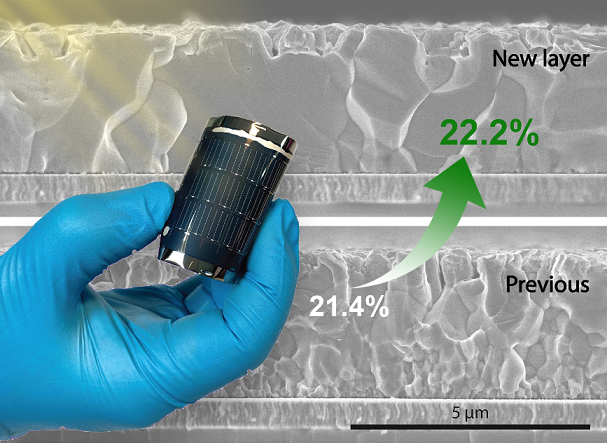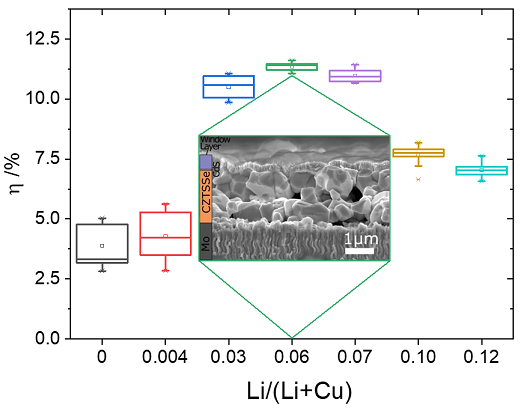Chalcogenide Thin-Film Solar Cells
Solar cells based on Cu(In1-xGax)Se2 (CIGS) thin film absorbers show very high efficiencies and performance stabilities. Empa has developed a scalable deposition process for CIGS thin-film solar cells suitable for high-speed and in-line production on flexible polymer foils. The thickness of the completed solar cell including the polymer substrate is less than 25 µm.
A world record efficiency of 22.2% was recently achieved, up from the 21.4% mark reported in 2021.
Main research topics include:
- engineering of band gap, composition and interfaces of the CIGS absorber for optimum device efficiency and upscaling potential,
- investigation of the solar cell electrical, optical properties as well as performance loss mechanisms,
- advances with alternative environmental-friendly processes for other constituent layers,
- development of low-bandgap absorbers for high-performance multijunction (tandem) solar cells
The development of highly efficient, stable, light weight and flexible solar cells is important for emerging markets such as building-integrated (BIPV), portable electronics, mobility as well as for aerospace applications. A spin-off of the group scales-up and commercializes solar modules based on the technology developed in the lab.

Selected publications:
- Yang, S. C., Lin, T. Y., Ochoa, M., Lai, H., Kothandaraman, R., Fu, F., Tiwari, A. N., Carron, R. (2023) Efficiency boost of bifacial Cu(In,Ga)Se2 thin-film solar cells for flexible and tandem applications with silver-assisted low-temperature process. Nature Energy. 8, 40–51.
- Yang, S. C., Sastre, J., Krause, M., Sun, X., Hertwig, R., Ochoa, M., Tiwari, A. N., Carron, R. (2021). Silver-promoted high-performance (Ag,Cu)(In,Ga)Se2 thin-film solar cells grown at very low temperature. Solar RRL, 5(5), 2100108 (6 pp.)
- Ochoa, M., Buecheler, S., Tiwari, A. N., & Carron, R. (2020). Challenges and opportunities for an efficiency boost of next generation Cu(In,Ga)Se2 solar cells: prospects for a paradigm shift. Energy and Environmental Science, 13(7), 2047 (9 pp.).
- Carron, R., Nishiwaki, S., Feurer, T., Hertwig, R., Avancini, E., Löckinger, J., Yang, Sh., Buecheler, S., Tiwari, A. N. (2019). Advanced alkali treatments for high‐efficiency Cu(In,Ga)Se2 solar cells on flexible substrates. Advanced Energy Materials, 9 (24), 1900408 (8 pp.).
- Feurer, T., Carron, R., Torres Sevilla, G., Fu, F., Pisoni, S., Romanyuk, Y. E., Buecheler, S., Tiwari, A. N. (2019). Efficiency improvement of near‐stoichiometric CuInSe2Solar cells for application in tandem devices. Advanced Energy Materials, 9 (35), 1901428 (6 pp.).
Kesterite thin-film solar cells
Kesterite is a thin-film solar cell technology. Its constituent metals (Cu, Sn, Zn, S and Se, in short CZTSSe) are abundant in the earth crust, thus it is a sustainable alternative to e.g. CIGS for the substitution of critical raw materials (CRM) like In and Ga. This also offers a secure supply chain as the metal production is distributed worldwide. Kesterite technology is also fully compatible with current CIGS production lines, thus it has a realistic potential to achieve the efficiency levels required for transferring the processes to relevant industrial environments.
Empa reached efficiencies up to 12.2% (active area) through lithium addition via a non-vacuum precursor synthesis route, close to the 12.6% world record. The main factor limiting the performance is explained by the large Voc-deficit.
Main research activities are:
- investigation on defect passivation via chemical treatments;
- engineering of absorber annealing and composition;
- analysis of defect type and concentration.

Selected publications:
- Cabas-Vidani, A., Choubrac, L., Márquez, J. A., Unold, T., Maiberg, M., Scheer, R., Li, H., Leifer, K., Pauer, R., Gilshtein, E., Tiwari, A. N., and Romanyuk Y. E., (2021). Influence of the rear interface on composition and photoluminescence yield of CZTSSe absorbers: a case for an Al2O3 intermediate layer. ACS Applied Materials and Interfaces, 13(16), 19487-19496.
- A. Cabas-Vidani, S. G. Haass, C. Andres, R. Caballero, R. Figi, C. Schreiner, J. A. Márquez, C. Hages, T. Unold, D. Bleiner, A. N. Tiwari, Y. E. Romanyuk, Adv. Energy Mater. 2018.

